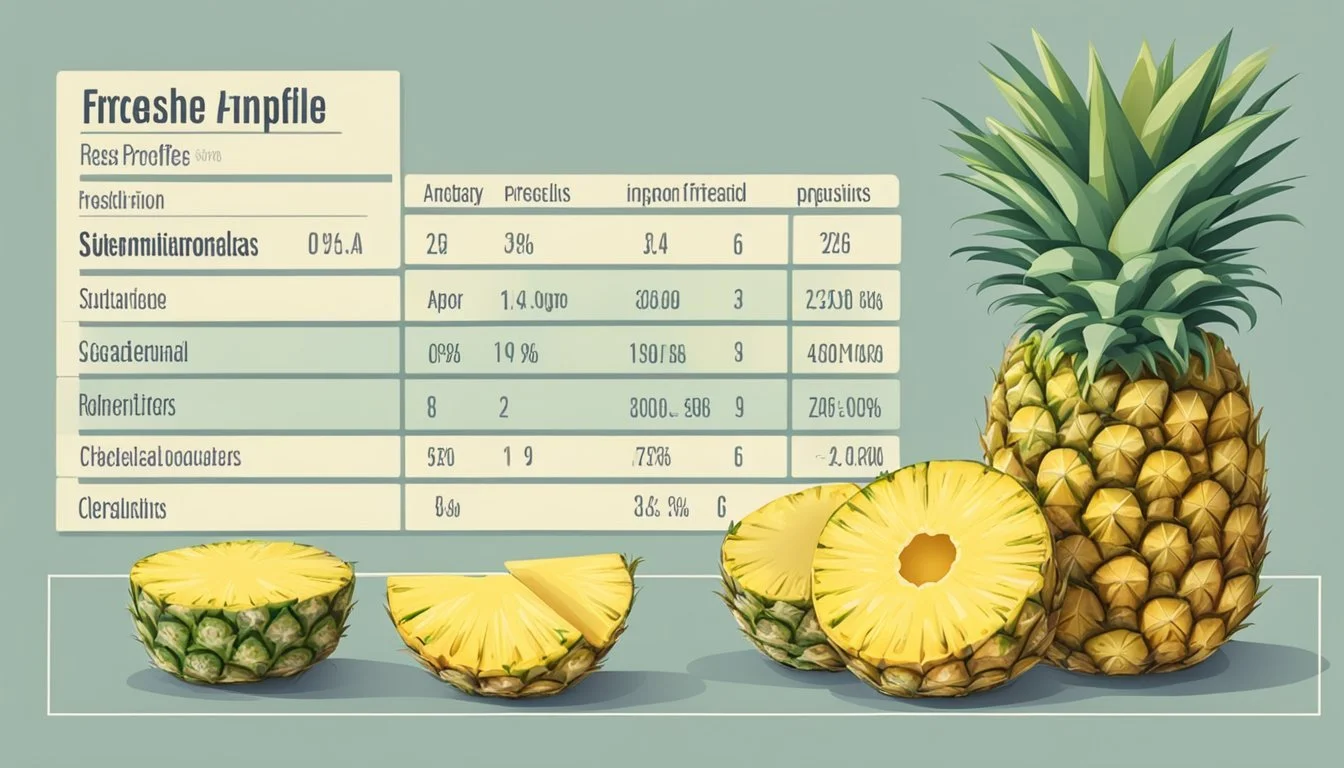Fresh vs Frozen Pineapple: Comparing Taste, Nutrition, and Convenience
Pineapple lovers often face a choice between fresh and frozen options at the grocery store. Both forms offer tropical sweetness and nutritional benefits, but they differ in key aspects.
Fresh pineapples provide slightly higher levels of vitamin C and other heat-sensitive nutrients compared to their frozen counterparts. However, frozen pineapples are typically picked at peak ripeness and flash-frozen, locking in many nutrients. This process can result in frozen pineapples retaining more vitamins and minerals than fresh ones that have traveled long distances or sat on shelves.
Convenience is a major factor when choosing between fresh and frozen pineapple. Fresh pineapples require peeling and cutting, while frozen chunks are ready to use. Frozen pineapples also have a longer shelf life, reducing food waste. Both types can be excellent additions to a balanced diet, offering fiber, vitamins, and antioxidants that support overall health.
Nutritional Profile Comparison
Fresh and frozen pineapple offer similar nutritional benefits, but some differences exist in their vitamin, mineral, enzyme, and sugar content. These variations can affect their overall nutritional value and potential health impacts.
Vitamin Content
Fresh pineapple typically contains higher levels of vitamin C compared to its frozen counterpart. A 100g serving of fresh pineapple provides about 47.8mg of vitamin C, while frozen pineapple offers around 30-40mg.
Vitamin A content remains relatively stable in both forms. Fresh pineapple contains small amounts of vitamin E, which may decrease slightly in frozen varieties due to processing and storage.
Vitamin B6 levels are comparable in fresh and frozen pineapple, with approximately 0.1mg per 100g serving.
Mineral Content
Mineral content in fresh and frozen pineapple is generally similar. Both forms provide essential minerals such as:
Manganese: 0.9-1.5mg per 100g
Copper: 0.1-0.2mg per 100g
Potassium: 100-150mg per 100g
Magnesium: 10-15mg per 100g
Frozen pineapple may have slightly lower mineral content due to blanching processes used before freezing. However, these differences are usually minimal and do not significantly impact overall nutritional value.
Enzymes and Antioxidants
Fresh pineapple contains higher levels of enzymes, particularly bromelain, compared to frozen varieties. Bromelain is known for its anti-inflammatory and digestive properties.
The freezing process can reduce enzyme activity, but it does not completely eliminate it. Antioxidant content, including flavonoids and phenolic compounds, remains relatively stable in both fresh and frozen pineapple.
Frozen pineapple may retain antioxidants better over time due to reduced exposure to air and light during storage.
Sugar and Caloric Differences
Fresh and frozen pineapple have similar sugar content and caloric values when no additives are present. A 100g serving of pineapple typically contains:
Calories: 50-55
Total sugars: 9-10g
Fiber: 1.4g
Frozen pineapple packaged without added sugars maintains a nutritional profile close to fresh pineapple. However, some frozen varieties may contain added sugars or syrups, increasing their calorie and sugar content.
It's important to check labels on frozen pineapple products to ensure no additional sweeteners have been added during processing.
Health Benefits
Pineapple offers numerous health benefits due to its rich nutrient profile and bioactive compounds. Both fresh and frozen pineapple can provide these advantages, though some differences may exist in nutrient content and enzyme activity.
Digestive Health
Pineapple contains bromelain, an enzyme that aids protein digestion. This enzyme can help break down food more efficiently, potentially reducing bloating and discomfort. Fresh pineapple typically has higher bromelain levels than frozen.
Fiber in pineapple promotes regular bowel movements and supports a healthy gut microbiome. One cup of pineapple provides about 2.3 grams of fiber, contributing to the recommended daily intake.
The fruit's high water content also aids digestion by preventing constipation and maintaining hydration.
Anti-Inflammatory Properties
Bromelain in pineapple exhibits potent anti-inflammatory effects. It may help reduce swelling and pain associated with various inflammatory conditions.
Studies suggest bromelain could be beneficial for arthritis, sinusitis, and sports injuries. However, more research is needed to fully understand its impact on chronic inflammation.
Pineapple's vitamin C content also contributes to its anti-inflammatory properties. This antioxidant helps neutralize free radicals and reduce oxidative stress in the body.
Immune Support
Pineapple is an excellent source of vitamin C, with one cup providing about 79% of the recommended daily intake. Vitamin C plays a crucial role in immune function by:
Stimulating the production and activity of white blood cells
Enhancing the skin's barrier function against pathogens
Acting as an antioxidant to protect immune cells from damage
The fruit also contains other immune-boosting nutrients like manganese and small amounts of zinc.
Heart Health and Disease Prevention
Pineapple's nutrient profile supports cardiovascular health in several ways. Its high vitamin C content helps protect against oxidative stress, a key factor in heart disease development.
The fruit's potassium content may help regulate blood pressure by counteracting the effects of sodium. This can reduce strain on the cardiovascular system.
Bromelain may have blood-thinning properties, potentially reducing the risk of excessive blood clotting. However, individuals on blood-thinning medications should consult their healthcare provider before consuming large amounts of pineapple.
Some studies suggest that pineapple's antioxidants and anti-inflammatory compounds may help reduce the risk of certain cancers. However, more research is needed to establish a definitive link.
Impact on Diet and Lifestyle
Pineapple offers versatile options for enhancing nutrition and supporting an active lifestyle. Its unique blend of nutrients and enzymes can benefit various aspects of diet and fitness.
Incorporating Pineapple into Meals
Fresh and frozen pineapple can be easily added to many dishes. For breakfast, it pairs well with yogurt or oatmeal. Lunch and dinner options include adding pineapple to salads, stir-fries, or grilled dishes.
Pineapple makes an excellent ingredient in smoothies, providing natural sweetness and tropical flavor. It can be blended with other fruits and vegetables for a nutritious drink.
For snacks, pineapple chunks offer a refreshing and low-calorie option. They can be eaten alone or combined with nuts or cheese for a balanced treat.
Frozen pineapple works well in recipes that call for a thicker texture, such as frozen desserts or blended drinks.
Weight Management
Pineapple can be a valuable ally in weight management efforts. One cup of pineapple contains only about 82 calories while providing 2.3 grams of fiber.
The fiber content helps promote feelings of fullness, potentially reducing overall calorie intake. This can support weight loss or maintenance goals when part of a balanced diet.
Pineapple's natural sweetness may help satisfy cravings for sugary foods, making it easier to stick to a healthy eating plan. It provides a guilt-free way to enjoy something sweet without added sugars.
The fruit's high water content also contributes to hydration and can help control appetite.
Fitness and Post-Workout Recovery
Pineapple contains bromelain, an enzyme that may aid in reducing inflammation and muscle soreness after exercise. This could potentially speed up recovery time between workouts.
The fruit's carbohydrates can help replenish glycogen stores depleted during intense physical activity. This makes it a good choice for a post-workout snack.
Pineapple's potassium content supports proper muscle function and can help prevent cramping. Its vitamin C aids in the production of collagen, important for joint health and tissue repair.
For endurance athletes, pineapple juice can be a natural alternative to sports drinks, providing both hydration and easily digestible carbohydrates.
Culinary Uses and Preparation
Pineapple adds a tropical sweetness to both sweet and savory dishes. Its versatility shines in various culinary applications, from raw preparations to cooked recipes.
Cooking with Pineapple
Pineapple enhances a wide range of dishes. In savory recipes, it balances rich flavors in marinades for meats like chicken adobo. The fruit's acidity tenderizes proteins, making it ideal for grilling.
For desserts, pineapple stars in classics like upside-down cake and fruit salads. It also works well in frozen treats such as sorbets and homemade ice cream.
Grilled pineapple slices make a delicious side dish or topping for burgers and tacos. The caramelization brings out the fruit's natural sweetness.
In beverages, pineapple adds tropical flair to smoothies and cocktails like piña coladas. Its juice can be used as a base for marinades or salad dressings.
Preparing Fresh vs. Frozen Pineapple
Fresh pineapple requires more prep work but offers superior texture. To prepare:
Cut off the top and bottom
Remove the skin
Cut out the core
Slice or dice as needed
Frozen pineapple comes pre-cut, saving time and effort. It's ideal for:
Smoothies
Baked goods
When cooking with frozen pineapple, thaw it first for best results. Pat dry to remove excess moisture before using in recipes.
Fresh pineapple works best in raw applications like fruit salads or as a garnish. Its crisp texture and bright flavor shine in these dishes.
For cooked recipes, both fresh and frozen pineapple perform well. The heat softens the fruit, minimizing textural differences between the two forms.
Storage and Shelf Life
Proper storage is crucial for maintaining the quality and extending the shelf life of pineapples. Fresh whole pineapples can be stored at room temperature for 2-3 days if ripe.
For longer storage, refrigerate whole pineapples for up to 5 days. Cut pineapple should be refrigerated in an airtight container and consumed within 3-4 days.
Frozen pineapple offers extended shelf life, lasting 3-5 months when stored properly. To freeze fresh pineapple:
Cut into chunks
Spread on a parchment-lined baking sheet
Freeze until solid
Transfer to freezer bags
Ripe pineapples should be used quickly for best flavor. Look for yellowing skin and a sweet aroma at the base.
In-season pineapples are typically fresher and may last longer. Peak season varies by region but often falls between March and July.
Canned pineapple provides a convenient long-term storage option, lasting 1-2 years in the pantry when unopened. Once opened, refrigerate and use within 5-7 days.
Always check for signs of spoilage before consuming, such as mold, off-odors, or significant color changes. Proper storage techniques help preserve the fruit's nutritional value and taste.
Economic and Environmental Considerations
Fresh and frozen pineapples have distinct economic and environmental implications. Their cost-effectiveness, availability, and carbon footprint vary depending on factors like production methods and transportation.
Cost-Effectiveness
Fresh pineapples can be more expensive, especially when out of season or transported long distances. Prices fluctuate based on supply and demand.
Frozen pineapples often offer a more stable, cost-effective option. They have a longer shelf life, reducing waste and allowing for bulk purchases.
In-season fresh pineapples from local sources may provide competitive pricing. However, frozen varieties generally maintain consistent pricing year-round.
Seasonal Availability and Carbon Footprint
Fresh pineapples have limited seasonal availability in many regions. This restriction can lead to increased transportation costs and higher carbon emissions when imported from distant locations.
Frozen pineapples are available year-round, potentially reducing the need for long-distance shipping during off-seasons. This availability can result in a lower carbon footprint for consumers in non-tropical regions.
The carbon footprint of pineapples is relatively low at 0.09 kg CO2e per pound. However, transportation and storage methods significantly impact their overall environmental impact.
Frozen pineapples require energy for processing and cold storage. Fresh varieties may have a lower processing footprint but higher transportation emissions when shipped internationally.
Pineapple Variety and Ripeness
Pineapples come in several varieties, each with unique characteristics. Determining ripeness is crucial for enjoying the fruit's optimal flavor and texture.
Types of Pineapple
The Smooth Cayenne is the most common commercial variety, known for its cylindrical shape and yellow flesh. It has a sweet-tart flavor and is often used in canned products.
Del Monte Gold, a hybrid variety, offers a sweeter taste and golden flesh. It's popular for fresh consumption due to its lower acidity.
The Sugarloaf pineapple, characterized by its white flesh and conical shape, is prized for its exceptionally sweet flavor.
Queen pineapples are smaller with a distinctive golden color and intense aroma. They have a delicate, less fibrous texture.
Red Spanish pineapples have a reddish-orange exterior and are more resistant to bruising, making them ideal for shipping.
Determining Ripeness
Color is not always a reliable indicator of ripeness, as pineapples don't continue to ripen after harvest.
A ripe pineapple should have a sweet aroma at the base. The stronger the fragrance, the riper the fruit.
Gently squeeze the pineapple. A ripe one will yield slightly to pressure without being soft or mushy.
The leaves should be fresh and green. Yellowing or browning leaves may indicate overripeness.
A heavier pineapple relative to its size often indicates higher juice content and better ripeness.
Ripe pineapples may have a slight give when you press the bottom. If it's too soft, it may be overripe.
Considerations for Special Diets
Certain health conditions and dietary restrictions may influence the choice between fresh and frozen pineapple. The fruit's sugar content and potential allergens are key factors to consider.
Diabetes and Sugar Management
Pineapple contains natural sugars that can affect blood glucose levels. The glycemic index of pineapple ranges from 51 to 73, indicating a moderate to high impact on blood sugar.
For diabetics, portion control is crucial. A 3/4 cup serving of pineapple has a glycemic load of 8.6, making it manageable in limited amounts.
Frozen pineapple may offer more precise portion control, as it's often pre-cut and easier to measure. This can help individuals with diabetes better manage their carbohydrate intake.
Fresh pineapple might have a slightly lower glycemic impact if consumed with the fibrous core, which can slow sugar absorption.
Allergies and Food Sensitivities
Some individuals may experience allergic reactions to pineapple, particularly to the enzyme bromelain. This protein-digesting enzyme is present in both fresh and frozen pineapple.
Symptoms of pineapple allergy can include:
Itching or swelling of the mouth and throat
Hives or skin rashes
Digestive discomfort
Frozen pineapple may contain fewer allergens, as the freezing process can potentially degrade some of the proteins responsible for allergic reactions.
For those with oral allergy syndrome, fresh pineapple might cause more immediate mouth and throat irritation. Frozen or canned pineapple could be better tolerated due to the processing methods.
Potential Health Risks and Side Effects
Pineapple contains bromelain, an enzyme that can have both positive and negative effects on health. In some people, bromelain may cause allergic reactions, ranging from mild to severe.
Symptoms of pineapple allergy can include itching, swelling of the mouth or throat, and difficulty breathing. Those with known allergies to pineapple should avoid consuming it in any form.
Eating large amounts of pineapple may lead to digestive discomfort. The high fiber content can cause bloating, gas, or diarrhea in sensitive individuals.
Bromelain's anti-inflammatory properties can interfere with blood clotting. People taking blood thinners or scheduled for surgery should consult their doctor before consuming pineapple.
The acidity of pineapple may erode tooth enamel with frequent consumption. Rinsing the mouth after eating pineapple can help mitigate this risk.
Some individuals report increased heartburn or acid reflux symptoms after eating pineapple due to its acidic nature.
While rare, excessive pineapple intake might lead to:
Nausea
Vomiting
Diarrhea
Menstrual bleeding changes
Moderation is key when incorporating pineapple into a balanced diet to minimize potential side effects while still enjoying its nutritional benefits.









